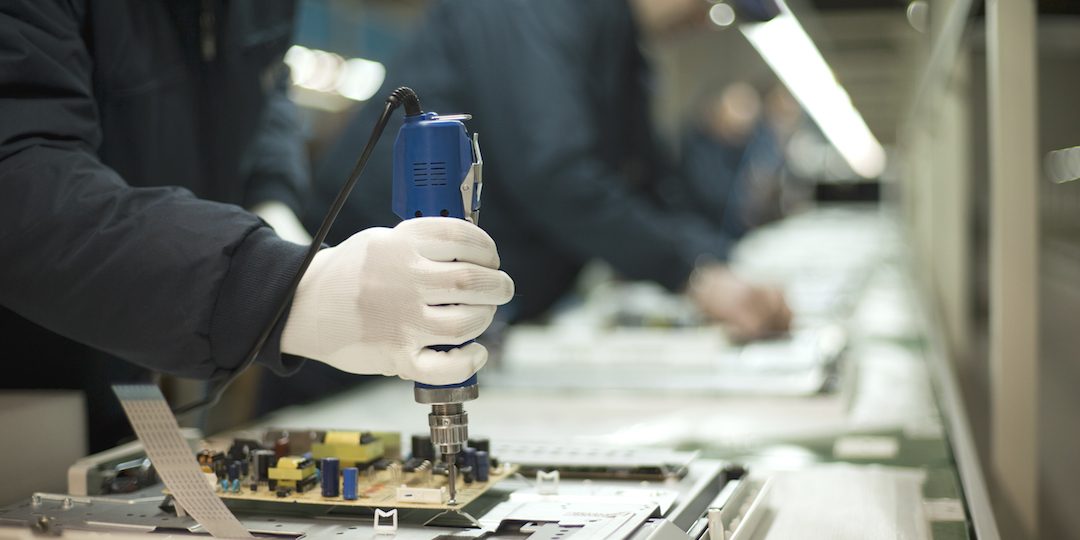This blog post is a supplement to the Brightidea podcast on how crowdsourced innovation is driving a renaissance in manufacturing.
“American made” is back in vogue. After years of prevalent offshoring, more and more U.S. manufacturing companies are bringing their operations back stateside in a practice known as reshoring. As job creation in the sector surges, companies are seeking ways to make the most of onshore talent in order to maintain their global competitiveness. Many are gaining proprietary advantage by generating valuable intellectual property through deep innovation. To make the most of that innovation, some companies are leveraging the power of crowdsourcing, harnessing the untapped potential of highly skilled engineering teams.
A Boomerang in Job Loss and Growth
Before its current resurgence, domestic manufacturing had been through some tough times. During the first decade of the new millennium, the sector suffered a staggering loss of 5.7 million jobs. It was a decline that, as a share of total manufacturing jobs (33 percent), exceeded the rate of loss during the Great Depression—making it the “worst performance in American history.” Although hardest hit were the manufacturing capitals in America’s “Rust Belt,” jobs in the sector declined in all 50 states, in some cases by nearly half.

Although hardest hit were manufacturing capitals in the “Rust Belt,” jobs in the sector sharply declined in all 50 states from 2000 to 2010.
So what triggered this widespread and sudden loss of manufacturing jobs? While other factors have certainly come into play, such as improved automation and increased efficiency, the main culprit, according the National Bureau of Economic Research, was a change in foreign trade policy. Specifically, the U.S. permanently granted normal trade relations to China in late 2000, leading to a dramatic rise in outsourcing and offshoring. As a result, by 2011, China surpassed the United States to become the world’s largest producer of manufactured goods. The U.S. was no longer the manufacturing behemoth it once was.
But now it seems the tide is turning. More and more U.S. companies are rethinking long-held business strategies of contracting their manufacturing operations overseas, and gradually returning them stateside. While catalyzing this shift is the current administration’s position on creating more American jobs, the strategy had already been proliferating. In fact, 2014 was the first year in two decades during which American manufacturing experienced a net gain in jobs, a growth trends that continues today.
Controlling IP and Maximizing the Talent Behind It
A number of factors have triggered the move towards reshoring. Among them are rising costs of Chinese labor, problems in Chinese manufacturing quality, and the positive corporate image of producing in America. But one in particular is noteworthy: the drive to sharpen the competitive edge of U.S. manufacturing by limiting the offshore exposure of its intellectual property and increasing the stateside talent to generate it.
Recently, the Commission on the Theft of American Intellectual Property found that offshoring results in the exposure and loss of IP worth $300 billion per year, with China responsible for as much as 80 percent of it. While some of that loss occurs through cyber-espionage, the majority of it is through traditional methods, including on-site stealing and bribery. A huge contributing factor has been the overseas distance in manufacturing supply chains, which makes it very difficult for major corporations to stop intellectual property leaks.
Bringing manufacturing operations back stateside in order to curtail the loss of IP, however, is not enough on its own. There has to be an accompanying strategy to maximize the full potential of a stateside labor force, the aim of which is to add greater value and proprietary advantage through existing resources.
With the rise of smart manufacturing, which applies advanced technologies to create more flexible and dynamic manufacturing processes, greater engineering brainpower and more highly skilled labor are now in demand. Hiring this talent increases the ability to improve those processes and resolve their problems, all while keeping operations stateside to protect IP. With a more highly skilled manufacturing workforce, maximizing its potential brainpower becomes all the more important. Doing so will boost a company’s innovation productivity and allow it to hone a more sharply competitive edge.
The Pursuit of Higher Quality and Deeper Innovation
Adding to the advantages of returning manufacturing operations stateside and increasing the skill of the labor behind it is the simple pursuit of quality. Not surprisingly, this applies to workmanship: “Made in China” is increasingly associated with shoddy manufacturing and unsafe products. But perhaps less obviously, pursuing higher quality manufacturing has implications for deeper innovation. One company demonstrating this in spades is Tesla, whose production of high-performance, all-electric automobiles has demonstrated that consumers will pay more for products featuring original design and sophisticated technology. That kind of proprietary advantage is in part what’s compelling increasingly more U.S. companies to reshore their operations, including Boeing, Caterpillar, KitchenAid, and even Apple (through its contractor, Flextronics).
 All of this strongly suggests that American manufacturing is becoming less of a race to the bottom—about whom can do it the cheapest—and more of a race to the top, using novel approaches to research, development, and production that culminate in superior products. In other words, the sector may start trending away from cost-based manufacturing (bent on increasing profit margins) and towards value-based manufacturing, which is focused on bringing to market innovative, quality-driven products for which consumers are willing to pay more.
All of this strongly suggests that American manufacturing is becoming less of a race to the bottom—about whom can do it the cheapest—and more of a race to the top, using novel approaches to research, development, and production that culminate in superior products. In other words, the sector may start trending away from cost-based manufacturing (bent on increasing profit margins) and towards value-based manufacturing, which is focused on bringing to market innovative, quality-driven products for which consumers are willing to pay more.
Crowdsourcing Innovative Solutions to Manufacturing Problems
Winning that race to the top hinges on elevating the depth and breadth of innovation in manufacturing. The key is for U.S. companies to harness the untapped potential of their highly skilled engineering teams. One effective way to accomplish this is by leveraging the power of crowdsourcing to solve technical problems that frequently arise in manufacturing. The most efficient route to that end is through specialized software.
Brightidea’s new Solve app uses the power of crowdsourcing to tap into the knowledge, skill, and creativity of a manufacturing workforce to find novel solutions to problems in research, design, development, and production. By helping to maximize the full potential of existing resources, the app enables stateside engineering teams to solve problems closer to home while retaining control over new intellectual property that might develop in the process. Manufacturers that accomplish these things can boost the productivity of their manufacturing operations, protect the underlying intellectual property, and ultimately gain a clear competitive advantage in the global marketplace.
To find out more about crowdsourced problem solving, listen to the podcast below. In it, Brightidea CEO Matt Greeley, Product VP Genevieve Wang, and Senior Product Manager Alison Heisner discuss in detail how forward-thinking U.S. manufacturing companies are using it find innovative solutions to their most pressing technical problems.
Solve is one of several apps in Brightidea’s innovation software.



